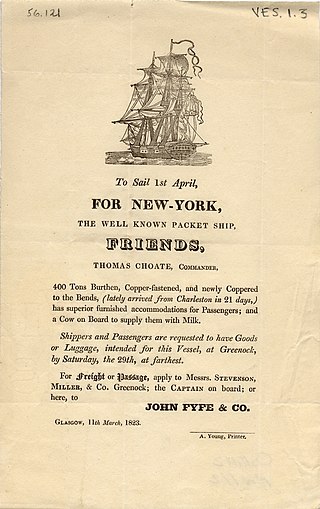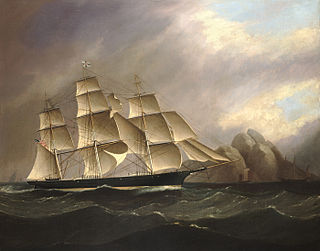
A clipper was a type of mid-19th-century merchant sailing vessel, designed for speed. Clippers were generally narrow for their length, small by later 19th-century standards, could carry limited bulk freight, and had a large total sail area. "Clipper" does not refer to a specific sailplan; clippers may be schooners, brigs, brigantines, etc., as well as full-rigged ships. Clippers were mostly constructed in British and American shipyards, although France, Brazil, the Netherlands, and other nations also produced some. Clippers sailed all over the world, primarily on the trade routes between the United Kingdom and China, in transatlantic trade, and on the New York-to-San Francisco route around Cape Horn during the California Gold Rush. Dutch clippers were built beginning in the 1850s for the tea trade and passenger service to Java.

Donald McKay was a Canadian-born American designer and builder of sailing ships, famed for his record-setting extreme clippers.

Champion of the Seas was the second largest clipper ship destined for the Liverpool, England - Melbourne, Australia passenger service. Champion was ordered by James Baines of the Black Ball Line from Donald McKay. She was launched 19 April 1854 and was abandoned 3 January 1877, off Cape Horn.

Lightning was a clipper ship, one of the last really large clippers to be built in the United States. She was built by Donald McKay for James Baines of the Black Ball Line, Liverpool, for the Australia trade.

Generally, packet trade is any regularly scheduled cargo, passenger and mail trade conducted by boat or ship. The boats or ships are called "packet boats or packet ships" as their original function was to carry mail.
Black Ball Line or Blackball Line may refer to:

James Baines was a passenger clipper ship completely constructed of timber in the 1850s and launched on 25 July 1854 from the East Boston shipyard of the famous ship builder Donald McKay in the United States for the Black Ball Line of James Baines & Co., Liverpool. The clipper was one of the few known larger sailing ships rigged with a moonsail.

Sovereign of the Seas, a clipper ship built in 1852, was a sailing vessel notable for setting the world record for the fastest sailing ship, with a speed of 22 knots (41 km/h).

The Black Ball Line was a passenger line founded by a group of New York Quaker merchants headed by Jeremiah Thompson, and included Isaac Wright & Son (William), Francis Thompson and Benjamin Marshall. All were Quakers except Marshall.

Grinnell, Minturn & Co. was one of the leading transatlantic shipping companies in the middle 19th century. It is probably best known today as being the owner and operator of the Flying Cloud, arguably the greatest of the clipper ships.

Red Jacket was a clipper ship, one of the largest and fastest ever built. She was also the first ship of the White Star Line company. She was named after Sagoyewatha, a famous Seneca Indian chief, called "Red Jacket" by settlers. She was designed by Samuel Hartt Pook, built by George Thomas in Rockland, Maine, and launched in 1853, the last ship to be launched from this yard.

The Donald McKay House is a privately owned historic house at 78–80 White Street in East Boston, Massachusetts. It was the residence of Donald McKay, a builder of clipper ships.

Packet boats were medium-sized boats designed for domestic mail, passenger, and freight transportation in European countries and in North American rivers and canals, some of them steam driven. They were used extensively during the 18th and 19th centuries and featured regularly scheduled service. Steam driven packets were used extensively in the United States in the 19th century on the Mississippi and Missouri rivers, supplying and bringing personnel to forts and trading posts.

Ocean Telegraph was a clipper ship that was built in Massachusetts in 1854 and was last known of in Gibraltar in 1923. She was in US ownership until 1863, when UK interests bought her and renamed her Light Brigade.

Comet was an 1851 California clipper built by William H. Webb which sailed in the Australia trade and the tea trade. This extreme clipper was very fast. She had record passages on two different routes: New York City to San Francisco, and Liverpool to Hong Kong, and beat the famous clipper Flying Dutchman in an 1853 race around the Horn to San Francisco.

Ocean Chief was a clipper ship used in a regular packet service and as a passenger ship for bounty emigrants to Australia between June 1854 and December 1861 at the time of the Australian gold rushes.

Coonatto, was a British three-masted clipper that was built in 1863 and wrecked in 1876. She traded between London and Adelaide for 12 years. She was wrecked in the English Channel in February 1876.

The SS Schomberg was a clipper built in Aberdeen by Alexander Hall & Co. for "the Black Ball line" for carrying large cargoes and steerage passengers, and to "outdo the Americans". When built, she was regarded as the most luxurious and well-built clipper of the period.

James Baines (1822 – 8 March 1889) was a British merchant, shipowner and shipbroker by trade. He became famous as the founder of James Baines & Co. that ran a fleet of 86 ships on the Liverpool Black Ball line between England and Australia in 1851–1871.

Donald McKay was an extreme clipper designed by Donald McKay, his last. Built for James Baines & Co., she sailed on the Black Ball Line of Liverpool from 1855 to 1868, carrying passengers and mail between England and Australia.





















